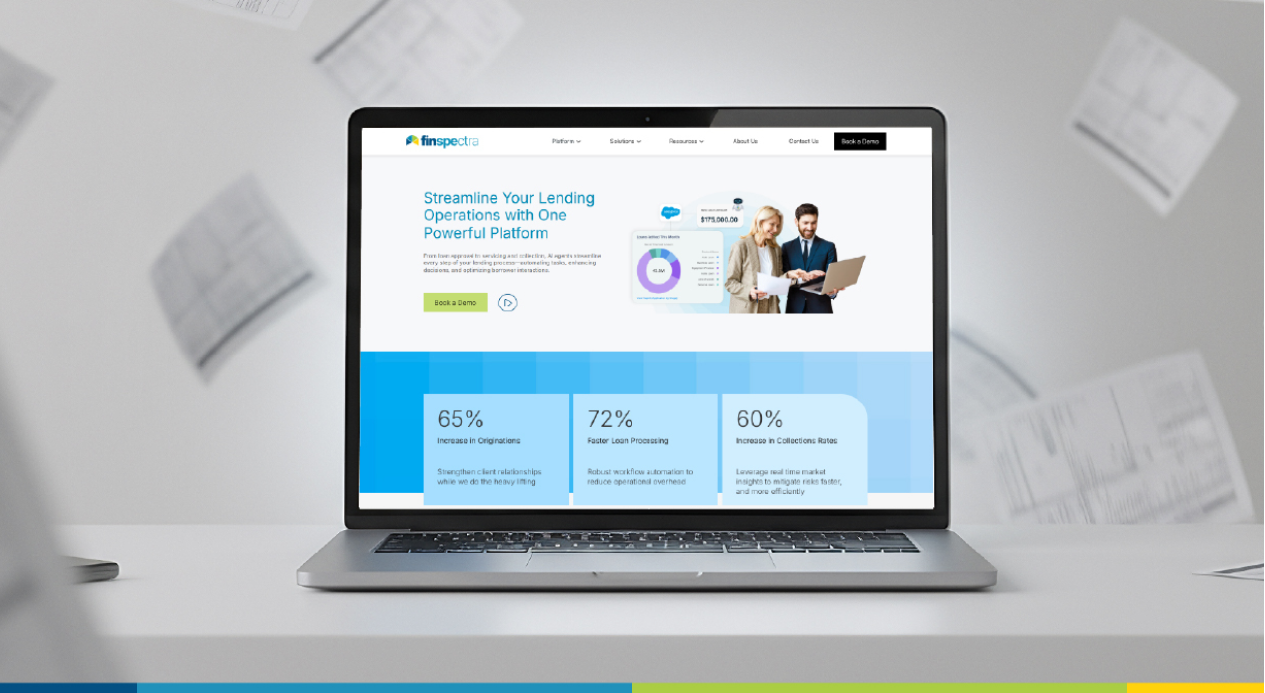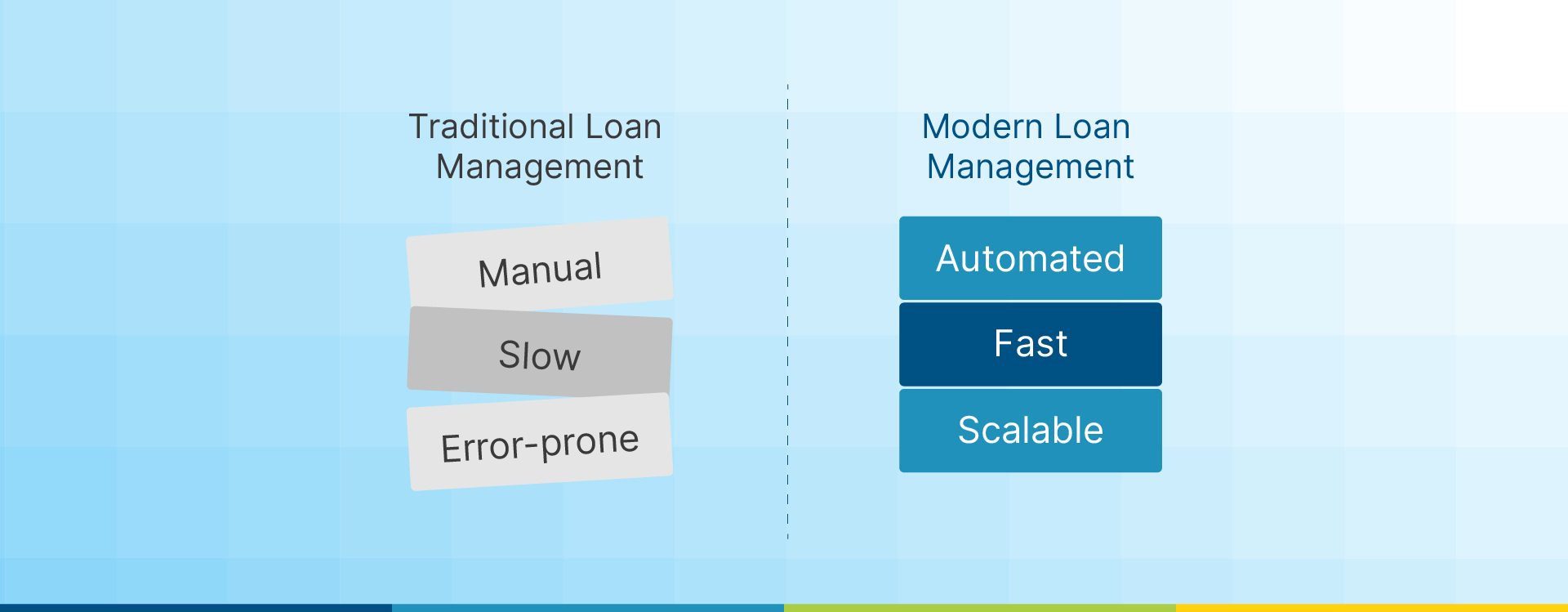Why Traditional Loan Management Is Falling Behind Modern Lending Needs

Traditional loan management systems were once the norm in lending. But as the world moves faster and digital solutions become the go-to choice for almost everything, these outdated systems are beginning to show their flaws.
What was once acceptable in a slower, more manual world is now a bottleneck for modern lenders and customers.
Loan officers are buried under stacks of paperwork, manual spreadsheets are constantly being updated with numbers, and loan approvals depend on paper files moving between desks…
Sound familiar? That’s traditional loan management, and while it served its purpose for years, it’s simply no longer enough.
In this blog, we’re going to break down why traditional loan management methods are falling behind, how they are impacting customer experience, and how modern digital solutions are stepping in to transform the entire process.
With advancements like automation, AI, and cloud-based systems, lenders now have the tools to speed up approvals, reduce errors, and offer a more seamless experience for both borrowers and themselves.
It’s time to explore why traditional loan management is becoming obsolete and how embracing modern technology can help lenders meet the demands of today’s environment.
What Are Traditional Loan Management Methods?
Traditional loan management methods are inefficient and rely on manual, paper-based systems. Loan officers process loan applications, review documents, and track repayments through spreadsheets or paper records. This creates a slow, error-prone system.
Imagine a loan officer who manually enters data into a spreadsheet to track loan repayments. As the loan portfolio grows, these spreadsheets will become harder to manage, leading to greater risks of mistakes and delays.
Manual processes impact customer satisfaction, and lenders are forced to add more resources to manage their loan portfolios.
Why Are Traditional Loan Management Methods Becoming Outdated?
Traditional loan management methods are slow, error-prone, and difficult to scale. Let’s break down why:
- Manual Errors and Inefficiencies
Manual processes increase the chances of mistakes. When loan officers rely on spreadsheets and paper records, errors like miscalculations in repayment schedules or missed payments are potentially higher. But these errors harm both the lender’s reputation and the borrower’s trust. - Slow Loan Processing
Traditional loan systems rely heavily on manual steps and intervention at every stage, resulting in slower approval times. Borrowers, meanwhile, expect quicker responses. Lenders who use these outdated methods often miss out on opportunities and/or leave customers frustrated. - Lack of Real-Time Tracking
Traditional systems don’t offer real-time updates. Loan officers often struggle to access current loan statuses, which delays decision-making and hinders the resolution of issues. Lack of transparency also means borrowers don’t get the timely updates they expect. - Limited Scalability
As lenders grow, traditional systems become harder to manage. Paper-based systems and spreadsheets require more staff and resources to maintain as the volume of loans increases, making it difficult to scale the business efficiently.

How Do Traditional Loan Management Methods Affect Customer Experience in Lending?
Traditional loan management methods negatively impact the customer experience in several ways. Slow processing, lack of transparency, and errors create frustration for borrowers, leading to a poor relationship with the lender.
- Slow Processing
Borrowers often have to wait days or weeks to receive updates on their loan applications or repayments. This delay can be caused by manual review processes and paper-based tracking, which can be frustrating for customers who expect fast responses. - Lack of Transparency
When borrowers can’t see real-time updates on their loan status or repayment progress, it creates uncertainty. In traditional systems, information is static and often outdated, leaving customers in the dark about important milestones like approval status or repayment deadlines. - Errors Impacting Borrowers
Manual errors, such as incorrect repayment amounts or missed payment reminders, can lead to serious problems for borrowers. These errors can result in late fees, higher interest rates, or even damaged credit scores. Modern lending helps in making borrowers feel supported by their lenders.
So if a borrower doesn’t receive timely reminders about upcoming payments due to outdated systems they may incur a late fee or default on a loan, damaging their credit rating.
The lack of efficiency, transparency, and accuracy in traditional loan management systems can severely harm a lender’s reputation. In a highly competitive lending market, this can lead to lost customers and reduced business opportunities.
What Technologies Are Shaping Modern Loan Management?
Modern loan management systems leverage powerful technologies that address the shortcomings of traditional methods. These advancements help streamline processes, reduce human errors, and provide a better experience for both lenders and borrowers.
- AI and Automation
Artificial intelligence (AI) and automation speed up loan processing by reducing the need for manual data entry. AI agents can interact with both borrowers and back-office teams in real time, answering borrower queries, collecting missing documents, or escalating exceptions. This shifts AI from being a back-end tool to being an active participant in loan servicing. - Cloud Computing
Cloud-based loan management systems allow lenders to access loan data from anywhere, at any time. This increases accessibility and collaboration while also ensuring that data is stored securely and can scale as the business grows. - Data Analytics
Data analytics provide real-time insights into loan performance, customer behavior, and potential risks. This enables lenders to make more informed decisions, identify trends, and manage risk more effectively.
For example, a cloud-based system that utilizes AI to automatically verify loan applications can drive data-led decision-making, reduce approval times from days to hours, and significantly enhance the customer experience.
Such modern technologies are becoming indispensable for any lending institution looking to stay competitive.

How Does a Modern Loan Management System Solve These Challenges?
Where traditional methods create delays and errors, modern systems digitize the entire loan lifecycle—from origination to repayment. The result is faster approvals, better visibility, and fewer mistakes.
- Automation Speeds Up Loan Processing
Beyond simple automation, modern systems now deploy AI agents that can independently handle routine tasks like verifying KYC documents, flagging compliance risks, or sending repayment reminders. These agents don’t just speed up processes; they reduce the need for constant human intervention and free up loan officers to focus on higher-value work. - Real-Time Data and Transparency
Modern systems offer real-time loan tracking, allowing both lenders and borrowers to stay informed. Customers can see their loan status and payment schedules at any time, leading to a more transparent and stress-free experience. - Enhanced Accuracy and Fewer Errors
By automating tasks like data entry and document verification, modern systems minimize human errors. This leads to fewer mistakes in loan tracking, repayment schedules, and customer communications.
To put this into an example, a borrower using a digital lending platform can receive instant updates on loan approval and repayment status, reducing the uncertainty and frustration common in traditional systems.
Modern loan management systems provide a seamless experience for both borrowers and lenders, enabling faster processing, greater accuracy, and improved customer service.
What Are the Key Differences Between Traditional and Modern Loan Management Systems?
The key differences between traditional and modern loan management systems highlight why the switch to digital solutions is essential for today’s lenders. Here’s a comparison:

- Automation vs. Manual Processing
Traditional systems rely on human intervention, which increases the chance of errors and delays. In contrast, modern systems automate most tasks, improving both speed and accuracy. - Transparency vs. Lack of Updates
Traditional methods provide little to no real-time visibility for customers. Modern systems allow both lenders and borrowers to track loan status at any time, ensuring transparency and trust. - Scalability
Traditional methods struggle to handle large volumes of loans, requiring additional administrative staff. Modern loan management systems scale easily to accommodate growth without adding significant overhead costs.
For example, a lender using an automated system can manage thousands of loans simultaneously with minimal staff, compared to a traditional system that would require much more manual labor.
How Do Online Loan Management Systems Improve Loan Tracking?
Online loan management systems dramatically improve loan tracking by providing real-time updates, automated notifications, and detailed reporting tools. Here’s how they help:
- Real-Time Loan Tracking
Online systems allow lenders and borrowers to track loan status instantly. Borrowers can check their repayment schedules, see upcoming due dates, and get updates on approval statuses without waiting for phone calls or emails. - Automated Reminders and Alerts
Modern systems automatically send reminders to borrowers for upcoming payments, reducing the chances of missed payments or defaults. This also benefits lenders by ensuring timely repayments and reducing the need for manual follow-ups. - Comprehensive Reporting
Online systems offer detailed reporting tools that give lenders insights into loan performance, borrower behavior, and potential risks. These reports help lenders make informed decisions and take proactive actions.
With an online system, a borrower can receive an automated reminder about an upcoming payment, which helps them stay on track without the need for a loan officer’s intervention.
Overall, online loan management systems streamline the tracking process for both lenders and borrowers, improving transparency and reducing manual intervention.
Bottom Line
Traditional loan management methods, while functional in the past, are no longer sufficient for meeting the needs of today’s fast-paced lending environment. The inefficiencies, errors, and lack of scalability inherent in manual processes create significant barriers for lenders and negatively affect the customer experience.
Modern systems deliver the speed, accuracy, and scalability lenders need to stay competitive. By automating processes, improving loan tracking, and offering real-time updates, they reduce costs and enhance customer experience.
Adopting a modern system isn’t just about improving efficiency; it’s about ensuring long-term success in an increasingly digital world. Ready to make the switch? Let us show you how PRIZM Lending Suite can simplify your loan management, reduce errors, and speed up your processes. Book a Demo with us today and start transforming your lending operations.
FAQS
1. What technologies are shaping modern loan management?
Technologies shaping modern loan management include AI, automation, cloud computing, and data analytics. These tools speed up approvals, reduce errors, and give lenders real-time insights into loan performance and risks.
2. How do traditional methods affect customer experience in lending?
Traditional loan management methods affect customer experience by creating delays, errors, and lack of transparency. Borrowers face slow approvals, limited updates, and mistakes in repayment schedules, leading to frustration and mistrust.
3. Why are traditional loan management methods becoming outdated?
Traditional loan management methods are outdated because they are manual, slow, error-prone, and hard to scale. Today’s lending environment demands speed, accuracy, and transparency, which outdated paper-based and spreadsheet systems cannot provide.
4. What are traditional loan management methods?
Traditional loan management methods use manual, paper-based processes and spreadsheets to handle origination, approvals, and repayments. These methods rely heavily on human intervention, making them inefficient, error-prone, and unfit for growing loan volumes.
5. How does a modern loan management system solve these challenges?
A modern loan management system solves challenges by using automation, real-time tracking, and cloud-based access. These systems speed up approvals, reduce manual errors, and give borrowers transparency, improving efficiency and customer satisfaction.
%201.avif)

















